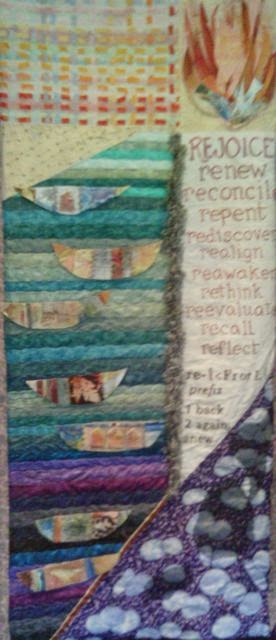The conversation of symbols with cloth and paint is the mark
of expression from me to others. I have often claimed to be a self-taught fiber
artist. But, really, my instructor has been God who has planted in me the gifts
of desire, curiosity and ability to use His designs in nature, humanity’s
appropriation of fibers grown from the Earth’s soil, with the addition of
sunlight and water, so many who have shared their gifts of talent and time
expressed in classes, books and magazines, and many art mediums displayed in
numerous venues, indoor and outside.
I have opened my posting with a picture of the Lenten art
quilt presently displayed in St. Ignatius Chapel on Loyola’s campus. It is one
in a series of Liturgical arts cloths placed during the year in the Chapel.
They were created in collaboration with a traditional artist in my faith
community. Recognizing the particular “seasons” of the Liturgical year is part
of the Christian rituals expressed in the change of colors, vestments, and readings
of the liturgies in churches that return year to year to the cycle of the
waiting for the Messiah now and at the second coming – the end time.
As noted by Cooke and Macy, “rituals aid interaction” (4).
In this case, the art cloths invite those praying during a liturgy or a visit
to the Chapel to enter a scene of travel or journey, “to choose a skiff and
travel to the Easter shore;” a “shared experience” of “insiders” discussed by
Cooke and Macy (11, 35), here, of Christians who recognize hope, transformation
and renewal during Lent in preparation for Easter, a celebration of our
salvation through Jesus (49).
Of course, if the art cloth were placed in a secular
environment or viewed by one without knowledge of Lent and Easter, the viewer
may simply enjoy or just see boats on water, a flame, and words that begin with
“re-.“ And that is fine, too. My goal is to not hit someone over the head with
meaning, but to provide comfort, inspiration and interest in something
different and new. Each of us comes to a ritual or symbol from a unique
perspective. While we may share a Judeo- Christian or Catholic background,
where we are in our lives probably shapes what we are seeking or accepting from
a ritual or symbol. In this way, “perceptions and understandings of reality
shape human reality,” and, perhaps, “symbols actually shape our reality,” as
suggested by Susanne Langer, the American philosopher (Cooke and Macy, 7). It
is in our growth as maturing Christians we may choose to use our freedom to
accept God’s wisdom through our “belief in the power of” the Holy Spirit and
reject evil in our world and “join together and support one another as [we]
work to bring justice and peace into the world” (49).

No comments:
Post a Comment